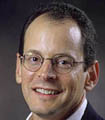
Jonathan Rauch
How to secure the homeland without leaving the house
http://www.NewsAndOpinion.com | The homeland-security worry of the month is chemical plants, and with good reason. More than 7,700 of them, according to the Environmental Protection Agency, are located in places where a thousand or more people could be injured in an accident or attack. Earlier this month, the Bush administration promised legislation.
Well, that's a start. But the country contains 66,000 chemical and hazardous-materials plants, according to the government. It contains 5,000 public airports. And 2,800 power plants, of which 104 are nuclear. And 80,000 dams. And 120,000 miles of major railroads. And 2 million miles of pipelines. And 590,000 highway bridges. And 500 major public transit operations. And more than 300 seaports. And almost 1,800 federal reservoirs -- never mind the municipal ones.
Each and every one of those facilities is a potential terrorist target. To guard even a significant fraction of them is a breathtakingly complex problem. Luckily, the solution may be breathtakingly simple.
In a room in Stamford, Conn., three video screens stand atop a conference table. They are connected to three motion-sensitive webcams, each pointed out the window to a street or parking lot outside. If a car passes, a camera e-mails its picture to a computer. The picture then pops up on the three screens, each asking a viewer just one question: "Do you see a person or vehicle in this image?" At the bottom of the picture are three radio buttons. "Yes." "No." "Not sure." And that's it. That, potentially, is the answer.
The system is called US HomeGuard, and the conference room adjoins the office of Jay Walker. The 47-year-old Walker is the chairman and founder of Walker Digital, a research company that invents and develops business systems. Walker's buttoned-down presentability seems more in keeping with an investor than an inventor, but he holds more than 200 patents, many of which, bound in scarlet, line his shelves.
After September 11, Walker notes, "We, like most people, said, 'OK, what can we do to create solutions to help prevent this from happening again?' " The company put together a team of a dozen or so people. They took about 10 months to find a problem they thought they could solve, and another six months to invent the solution. The problem was trespassers. The solution was citizen watchmen, working over the Internet. Most critical infrastructure sites -- power plants, dams,
oil-storage facilities, and so on -- are located in restricted areas, places where no one except authorized personnel (maintenance or security staff, for example) should ever be. The problem is how to watch all those places. Foot patrols would be prohibitively expensive. Closed-circuit cameras would require full-time monitoring, and the lack of anything to watch would soon lull the human monitors to sleep. Terrorists, in any case, could go wherever patrols or monitors weren't looking.
"The terrorists are using our systems against us," Walker says. "We've got to use the same systems for us." Instead of bringing guards to the critical infrastructure, bring the infrastructure to the guards.
HomeGuard begins with webcams, arrayed at 100-foot intervals along the periphery of a restricted site. The webcams are about the size as a digital camcorder and cost about $1,000 each. Covering a mile of fence would cost about $75,000, which would add up to about $250,000 for an average industrial plant. For larger peripheries -- say, an airport -- just add more cameras. Each camera snaps a picture at regular intervals -- and every time it detects motion.
That, of course, is the easy part. The hard part is watching the cameras. HomeGuard connects the cameras, via wireless e-mail, to data centers that, in a matter of seconds, screen out all photos in which no change or movement has occurred. Fewer than one in a thousand pictures remains, but that still leaves a lot of pictures. The system then e-mails each questionable picture to three spotters, and asks whether a person or vehicle is visible.
Spotters? These are ordinary people who enlist to screen pictures over the Internet. They sign up online and can work whenever they like, for five hours or five minutes. Sitting at home or anywhere else with Web access, they log on to HomeGuard's site and look at pictures, saying only whether they see a person or vehicle in the pictures that appear. Crucially, these spotters have no idea what they're seeing pictures of. One image might show a length of chain-link fence, the next a door, the next a catwalk. All they do is say whether they see a person or vehicle and then click. Next picture.
They're paid for every 100 pictures they evaluate. They can work at their own speed, but if a spotter doesn't respond to a picture after 20 seconds (perhaps she has gone to get a sandwich), the system simply e-mails that picture to another spotter. The system just needs three replies -- it doesn't care from whom, or from where. "There is no 'local' here," Walker says. Americans at the airport in Bangkok could log in as spotters while waiting for their flight to Taipei.
What if a spotter isn't paying attention? Interspersed with real pictures are test photos, sprinkled liberally into the mix to check the checkers. People who are not paying attention (or who are trying to mislead the system) can quickly be sequestered and given training or bounced off.
Suppose one or more spotters see a person or vehicle in a no-go zone? The data center immediately sends the same picture, plus photos from nearby cameras, to a dozen or more other spotters. If those spotters confirm the presence of a person or car, it's considered definite. Then professionals take over.
Specifically, an alarm goes off at a security center. There, the photos in question come up on a screen in front of trained personnel who, unlike the amateurs, know where the site is and who is allowed to be there. Broadcasting over the Internet, and using microphones and speakers installed in the cameras, they can challenge the person in the picture on the spot. "Who are you? May I see your identification?" A maintenance man might be asked to wait while his identity is confirmed with local management. If the person runs away, his picture can be e-mailed directly to local authorities. The whole process, from intrusion to intervention, can take place in 30 seconds or less. Or so says Walker.
"By using citizens," he says, "we can cover an enormous amount of real estate without burdening professionals with things they don't need to do." No less important: None of those citizens would need to do anything complicated or risky. "We've modeled this system on the human brain," Walker says. Each spotter is like a neuron, firing a simple binary response. "The neuron doesn't know what the brain is thinking." It doesn't need to know. The intelligence is in the system.
Like a neural net, HomeGuard is, in principle, highly redundant -- and thus robust. The sprawling Internet, with its countless pathways, cannot be easily taken down. Spotters could be literally anywhere. Cameras would constantly report their own presence, triggering a security response if shut off. Privacy concerns would be minimal, since all the areas under surveillance would be off-limits to begin with.
As for the technology, all of it, Walker says, is currently available, either off the shelf or with inexpensive modifications. About 100 million Americans use the Internet every month, he notes, so potential spotters abound. The data-crunching requirements are of the scale that eBay's processing centers handle every day. All that remains is to try it out. Walker says that a $40 million government investment could fund a live prototype by the end of the summer. If the system worked, it could be scaled up rapidly. Implementation could be months, not years or decades, away.
Since unveiling the idea in February, Walker has made a dozen or so presentations to policy makers in Washington. He proposes to sell the patents to the government for $1. Asked how his sales pitches are going, Walker replies dryly: "Urgency and Washington aren't brother and sister."
Here is something those policy makers might want to think about. In the course of preparing sample images for its HomeGuard mock-ups, Walker Digital sent people to take pictures of 70 or more power plants, dams, oil-storage tanks, and other sensitive sites. It sent men dressed in hooded outfits, and carrying large black satchels, to pose as suspicious intruders. How often were these mock intruders challenged? Not even once.
![]()
Michael Kelly, who died last week covering the war in Iraq,
was my boss, my teacher, my friend. He was as brilliant
an editor as he was a reporter, but in truth he seemed restless
behind a desk. I draw some consolation from knowing that
he died with his boots on, which is how he would have wanted
to go, if go he must. In death, as in life, he made us proud.
JWR contributor Jonathan Rauch is a senior writer and columnist for National Journal. Comment by clicking here.
04/02/03: It's time to break up the college color cartel
03/18/03: Yes, Bush Has A North Korea Policy. It Might Even Work
03/04/03: Can a young Dem save his party from itself?
02/20/03: America can beat Iraq. But can it vanquish France?
02/04/03: Stop whining, America, and get serious about Smallpox
01/23/03: Has Bush bitten off too much?
01/08/03: With a hum instead of a roar, the fuel-cell is here
12/12/02: Forcing Americans to put their money where their mouths are
09/30/02: Once again, a President Bush saves the U.N. from its friends
05/08/02: The world on a screen
03/12/02: To make peace, should Israel first take back land?
02/22/02: A NYTimes columnist defends his paper's principles
02/14/02: Bush's gas tax
01/31/02: Don't Fear Bin Ladenism's Strength. Fear Its Weakness
01/17/02: Next Stop In The War Against Terrorism: Damascus
01/03/02: Countering the smallpox threat
12/06/01: Discovered! The Mullahs' minutes, or: How to end Western society
11/05/01: Why Bush (Senior) Didn't Blow It in the Gulf War
10/01/01: Charter Schools: A New Hope For America's Latinos
09/20/01: What leaders said about the attack--and what they meant
08/22/01: They Secretly Cloned Mozart!

